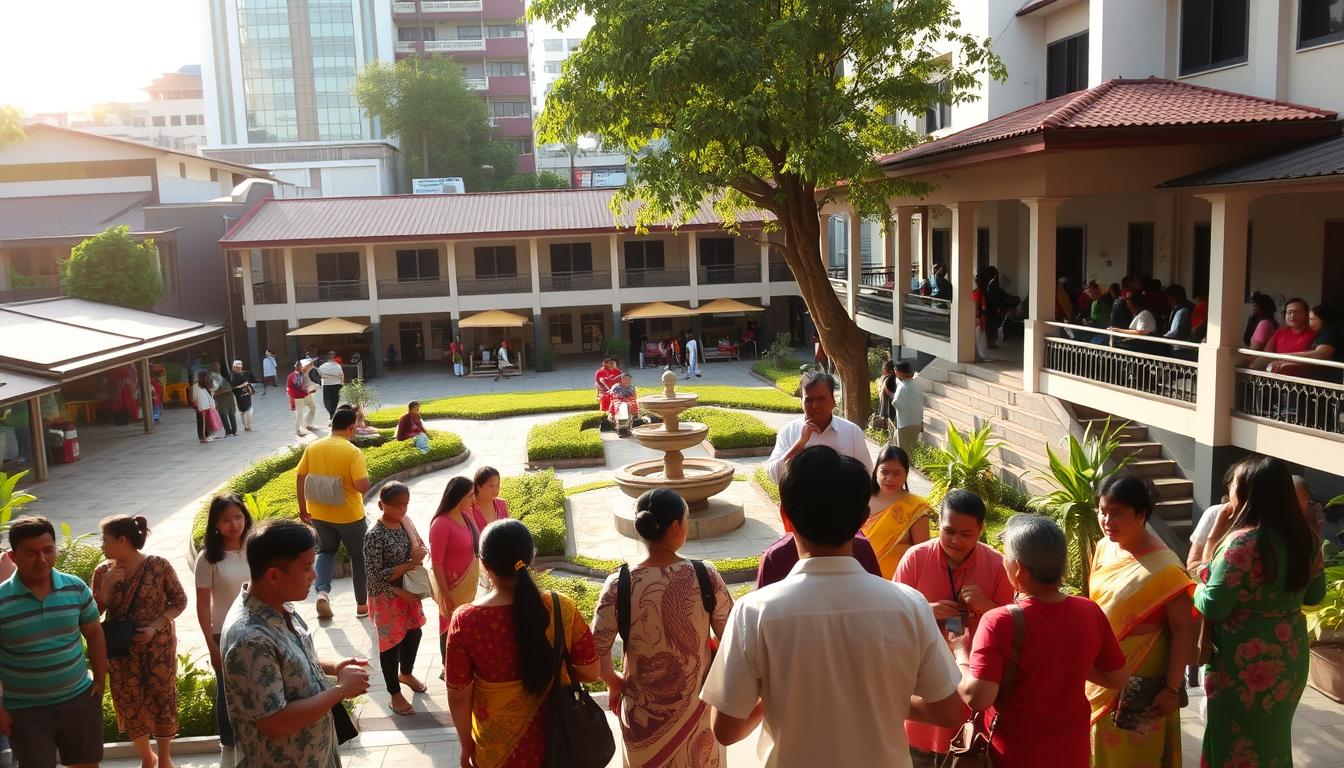Ever thought about how a simple word can connect us to a whole community? In Malaysia, the word kamu is key to talking to groups and feeling part of something bigger.
Getting the hang of kamu is important for talking well and building communities. Knowing when and how to use it helps you connect with the local culture better and make stronger bonds.
We’ll show you why kamu matters and how it shapes community life. We’ll help you understand the rich culture of Malaysia.
Key Takeaways
- Understanding “kamu” is crucial for good communication in Malaysia.
- The term “kamu” is important for building communities and connecting with culture.
- Knowing how to use “kamu” helps you feel at home in Malaysian society.
- Using “kamu” well can strengthen your ties with the local community.
- Grasping “kamu” is essential for exploring Malaysia’s complex culture.
What is kamu and why is it important in Malaysia?
“Kamu” is more than a word; it’s a key to understanding Malaysian values and customs. It helps us see the importance of “kamu” in Malaysian society. We’ll look at its definition and cultural value, showing how it helps with social networking and community bonds.
Definition of kamu
“Kamu” is a pronoun for addressing groups or individuals, formal or informal. In Malaysia, “kamu” shows the country’s rich linguistic and cultural diversity. Knowing “kamu” helps us appreciate Malaysian communication and build stronger community ties.
Cultural significance in Malaysian society
The role of “kamu” in Malaysian culture is huge. It stands for respect, inclusivity, and community. Using “kamu” right shows belonging and solidarity, making the community and social networking stronger among Malaysians.
In daily life, “kamu” shapes social interactions and cultural norms. It shows respect for tradition and cultural heritage while meeting modern communication needs.
The different contexts in which kamu is used
Knowing when to use ‘kamu’ is key for clear communication in Malaysia. This term is a pronoun used in many places, affecting how we talk. It changes the meaning and feel of our words.
In casual talks, ‘kamu’ is a favorite among friends. It’s a friendly way to say ‘you’ that fits well in Malaysian culture.
Everyday language
In daily chats, ‘kamu’ is used freely. It’s perfect for talking with loved ones or online. This is because it’s informal and easy to understand.
On social media, ‘kamu’ helps build a sense of togetherness. It’s especially common among the young who spend a lot of time online.
Formal settings
But ‘kamu’ also fits into formal situations, like work or official events. The way it’s used changes a lot.
In formal places, ‘kamu’ is used with more respect. For example, in meetings, it helps everyone work together better. It makes communication smoother.
| Context | Usage of ‘kamu’ | Example |
|---|---|---|
| Everyday Language | Informal, casual | “Kamu nak pergi mana?” (Where are you going?) |
| Formal Settings | More structured, polite | “Kamu semua dipersilakan hadir” (You are all invited) |
| Online Platforms | Informal, engaging | “Kamu boleh like dan share post ini” (You can like and share this post) |
By knowing when to use ‘kamu’, we can talk better in Malaysia. It helps us communicate well in all kinds of situations.
How to properly address someone using kamu
To connect well with people in Malaysia’s digital world, knowing how to use “kamu” is key. It’s about grasping the cultural subtleties and when to use it.
When you say “kamu,” think about Malaysia’s social hierarchy. This shows respect to those who are older or in charge.
Hierarchical considerations
In Malaysia, age and status matter a lot in how you address someone. For example, using “kamu” with someone much older or in a higher position might not be right without the right titles.
Being aware of these rules helps us connect better and build strong bonds online.
Regional variations
Malaysia is a mix of cultures and languages, with each area having its own ways. How “kamu” is used can differ, making it important to know these differences.
In some places, “kamu” is for casual talks, while in others, it’s for formal chats. Knowing these differences helps us communicate better.
By understanding these regional and social rules, we can use “kamu” in a way that’s both respectful and engaging. This strengthens our ties with the Malaysian digital community.
Common misunderstandings about kamu
“Kamu” is often misunderstood by locals. It’s a pronoun used in many ways, but its meaning changes based on the situation and people involved.
Misinterpretations among locals
In daily talk, “kamu” can mean friendliness or respect. But, it can also seem informal or even rude if not used right. For example, using “kamu” to someone much older or in authority might seem disrespectful.
The nuances of “kamu” usage are complex and multifaceted, needing a deep grasp of the cultural context.
| Context | Interpretation |
|---|---|
| Formal setting | Respectful |
| Informal setting | Friendly or casual |
| With elders | Potential disrespect if not used carefully |
Impact on communication
Misunderstanding “kamu” can really affect how we talk, especially in diverse places like Malaysia. Good community building needs clear and respectful talk.
Knowing how to use “kamu” right is key for a strong, welcoming online community. Being mindful of possible missteps helps us handle social situations better.

In summary, “kamu” is crucial in Malaysian culture, but using it right is important to avoid confusion. By teaching about “kamu,” we can improve how we talk and build stronger communities.
Tips for using kamu effectively
In Malaysian society, ‘kamu’ is very important. Learning to use it right can make your social networking better. It takes practice and understanding cultural details.
Practice Scenarios
To get good at ‘kamu,’ practice in different situations.
- Do role-playing with friends or language partners.
- Use ‘kamu’ in formal and casual settings.
- Try different tones to show respect or closeness.
A language expert says,
“The more you practice ‘kamu’ in real-life situations, the more naturally it will come to you.”
Listening to Native Speakers
Listening to native speakers is key to mastering ‘kamu.’
Watch how native speakers use ‘kamu’ in talks. Note the context and tone. Watch Malaysian TV shows or movies to see ‘kamu’ in action.
Practice and listen to native speakers. This will help you use ‘kamu’ well in social talks.
The role of kamu in Malaysian identity
‘Kamu’ is more than a pronoun; it shows Malaysian values and community. In Malaysian culture, ‘kamu’ means respect, solidarity, and unity.
Looking into ‘kamu’, we see it’s key to Malaysian identity. It’s not just a word but a symbol of the country’s rich cultural heritage.
Reflecting diversity in language
‘Kamu’ is used by different ethnic groups in Malaysia. This shows the country’s language diversity. It’s a sign of Malaysian culture’s unity.
- In everyday talks, ‘kamu’ greets friends, family, and colleagues.
- In formal talks, ‘kamu’ shows respect to elders or those in charge.
- ‘Kamu’ is flexible for many social situations, promoting group collaboration.

Expressing solidarity
‘Kamu’ also shows solidarity among Malaysians. It brings a feeling of belonging and unity, vital in a multicultural society.
Using ‘kamu’ shows one’s connection to the community and teamwork. This is clear at cultural events and festivals, where ‘kamu’ boosts unity and cooperation.
At national celebrations, ‘kamu’ strengthens shared identity and group collaboration. It’s a strong symbol of Malaysian unity.
Resources for learning more about kamu
Learning about “kamu” is easier with the resources we’ve found for you. We’ve collected materials to help you understand and use “kamu” in Malaysian culture. These resources cater to different learning styles.
Books and Academic Articles
For those who like to read deeply, there are books and articles on “kamu” in Malaysian language and culture. These resources offer a detailed look at the term’s importance and uses. You can find linguistic studies on Malaysian dialects and cultural analyses of communication in Malaysia.
One study shows how “kamu” helps build community and solidarity. A well-known linguist said,
“The use of ‘kamu’ reflects a deep-seated cultural value of inclusivity and respect for the collective identity.”
This insight is great for those wanting to grasp the subtleties of “kamu.”
Online Courses and Language Apps
Online courses and language apps are great for learning about “kamu” today. They offer interactive lessons, quizzes, and exercises to improve your “kamu” skills. You can find these resources on popular online learning platforms, fitting your schedule and learning style.
Look for online resources with features like discussion forums and community feedback. For example, an online course might have a module on “kamu” that covers its use in various situations. It also offers interactive exercises to practice.
| Resource Type | Description | Level |
|---|---|---|
| Books | In-depth analyses of “kamu” in Malaysian culture | Advanced |
| Online Courses | Interactive lessons on using “kamu” in context | Beginner/Intermediate |
| Language Apps | Practice exercises for improving proficiency | All Levels |
By using these resources, you can improve your understanding and use of “kamu.” Whether you like traditional learning or modern online platforms, there’s something for everyone.
Engaging with the community using kamu
Using ‘kamu’ is more than just speaking. It’s about making connections and feeling like you belong. When we use ‘kamu’ correctly, we start deeper talks with others.
Participating in local events
Going to local events is a great way to use ‘kamu’ in real life. Events like cultural festivals or community fairs are perfect. They let us meet locals and see how ‘kamu’ works in different situations.
“Kamu adalah keluarga kami” (You are our family) is a common welcome at these events. It shows the community’s warmth and sense of togetherness.
Volunteering and outreach
Helping out in outreach programs is another good way to use ‘kamu.’ Helping others not only improves our language but also helps build the community. This way, we learn more about ‘kamu’ and how it brings people together, even online.
- Join local volunteer groups to practice ‘kamu’ in meaningful contexts.
- Participate in community outreach programs to understand the cultural nuances of ‘kamu.’
- Engage in online forums and social media groups to extend your ‘kamu’ practice into the virtual community.
By using ‘kamu’ to connect with the community, we improve our language and become part of it. We help make the culture richer and more welcoming for everyone.
Our commitment to helping you with your language journey
As we explore “kamu” in Malaysian culture, we’re here to support you. We aim to give you personalized help. This will help you build a strong base in the language.
Guidance for Language Learners
We tailor our support to make you confident with “kamu”. Our expertise will help you connect with the local community. This will boost your social networking chances.
Connecting You to the Digital Community
We’re not just about teaching language. We want to help you join the digital community. Our resources will connect you with people who share your interests.
Join our community to meet learners and native speakers. This will help you improve your language skills. We’re excited to be part of your journey and help you reach your goals.
FAQ
What does “kamu” mean in Malaysian context?
“Kamu” is a word used to talk to a group of people. Its meaning changes based on the situation. It’s key in Malaysia for clear communication and connecting with others.
How is “kamu” used in everyday language?
“Kamu” is a flexible term used in many situations. It helps in both casual and formal talks. It’s great for working together and building communities.
Are there regional variations in using “kamu”?
Yes, “kamu” is used differently in different places. Knowing these differences helps avoid mistakes. This is especially true in Malaysia, where it’s used online and in digital groups.
Can “kamu” be used in formal settings?
Yes, “kamu” is okay in formal situations. But, you need to think about the setting and the people you’re talking to. This ensures respect and engagement in the community.
How can I practice using “kamu” effectively?
To get better at using “kamu,” try practicing with scenarios. Listen to how native speakers use it. Also, join local events to connect with the community and improve your language skills.
What are some common misunderstandings about “kamu”?
People often get “kamu” wrong, which can mess up communication. Knowing these mistakes helps you connect better with others online. It makes your interactions more meaningful.
Where can I find resources to learn more about “kamu”?
You can learn about “kamu” from books, articles, online classes, and language apps. These resources will deepen your understanding of “kamu” and its role in Malaysian culture. They’ll also improve your language skills.
How does “kamu” contribute to Malaysian identity?
“Kamu” is important in showing Malaysia’s language diversity. It helps people feel united and work together. It’s key in building a strong digital community.

